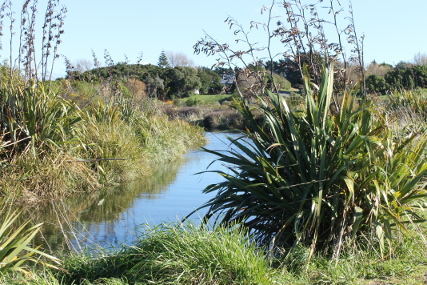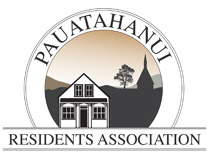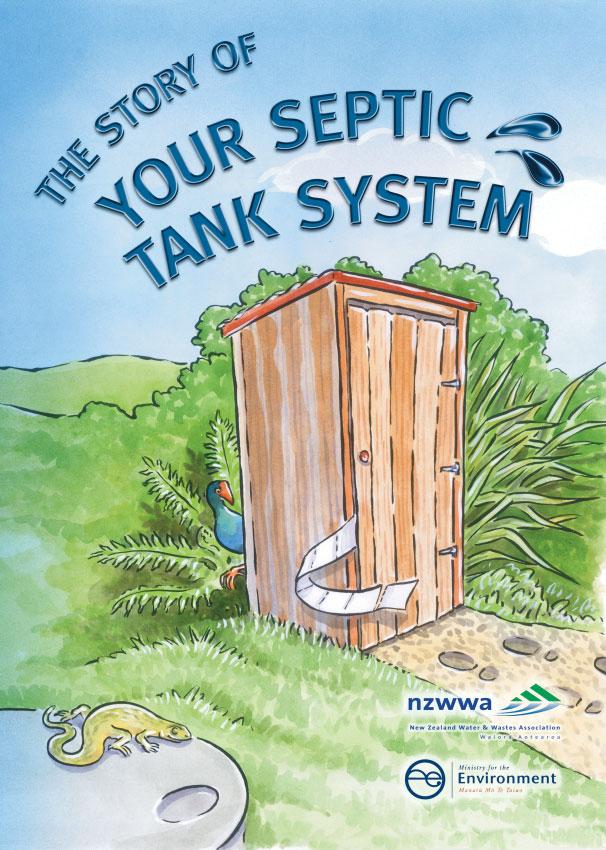Water Management
Rural properties in the Pāuatahanui area are required to be self-reliant for water management. Unlike city properties supplied by Wellington Water, residents on rural properties all need to manage drinking (potable) water, waste disposal and stormwater.
Sewerage
Any residence or building containing a toilet must be connected to an approved onsite wastewater system. All systems must have a permit from Porirua City Council Onsite wastewater system permits
and comply with Greater Wellington’s Discharges to Land rules
Rule 7 On-site sewage treatment and disposal
Septic systems must be installed by a qualified person, authorised by Porirua City Council, and be correctly maintained. Maintenance requirements will differ according to the type of system that is installed.
A septic tank system works by bacteria in the tank/s breaking down waste solids, with associated water dispersed to ground via a drainage field or evaporating through a transpiration system.
In order for septic systems to work well there are a few key Dos and Don'ts:
Do’s
✔ Use bio-degradeable detergents and cleaners
✔ Check all cleaners to see if they are suitable for septic tanks, and check contents labels frequently, as chemicals in cleaners can change
✔ Scrape all dishes to remove fats and food particles before washing - fats are best burnt or buried, NOT flushed
✔ Shake sand and dirt from clothes before putting them in the washing machine
✔ Control the use of water by installing water reduction devices like dual-flush toilets, low-flow shower heads, spray nozzle taps etc
✔ Have showers instead of baths
✔ Fix leaking taps
✔ Maintain and protect all plants and landscaping that is part of the soakage treatment area
✔ Keep livestock off the soakage treatment area because they can damage distribution pipes and compact the soil
✔ Plant borders or low hedges around the soakage treatment
area to separate it from the rest of the property
✔ Alternate between two areas every three to six months (if the system was designed to do this)
Don’ts
✘ Use huge amounts of cleaners
✘ Put cleaners designed to kill bacteria e.g. Dettol, Janola down sinks or toilets
✘Pour toxic chemicals like paints, thinners, oils, or pesticides down drains
✘ Pour fats down drains
✘ Use kitchen sink waste disposal units
✘ Put coffee grounds, sanitary napkins, disposable nappies, etc into toilets or sinks
✘ Do all the laundry in one day without checking system capacity
✘ Empty lots of water into the system from pools or tanks
✘ Let stormwater into the septic tank, either from the roof or from the surrounding land
✘ Build driveways or buildings on top of the soakage treatment area or drive over it
✘ Grow deep rooting trees or shrubs over the soakage treatment area
✘ Let rainwater flow onto the soakage treatment area from roofs, driveways, or uphill areas
✘ Let effluent pond on the ground surface. If this is happening, the soakage treatment area is blocked and to be fixed or replaced
Guidelines for on-site sewage systems.pdf provides more detailed information for installing septic tank systems in the Wellington region.
Potable (drinking) water
Drinking water, also known as potable water, is water that is safe to drink or to use for food preparation.
Whilst Councils providing water to homes are covered under the Drinking Water Standards for New Zealand 2005 (Revised 2018), there is no monitoring of the standard of drinking water at an individual property level. It is the responsibility of landowners to ensure that their drinking water supply is safe for human consumption.
A new building consent from Porirua City Council includes requirements for the collection, storage and treatment of water for household use. These requirements usually require a system for roof rainwater collection, storage tanks and a filtration unit.
Existing properties may get their domestic water supply from other sources including
- springs
- streams
- bores
Regardless of the source, It is important that potable water supplies are sources of healthy water. Water testing can be arranged
https://www.hill-laboratories.com/analytical-testing/water-testing/drinking-water/
During dry periods, when there is insufficient rainfall to keep tanks full, residents may need to get their tanks filled from a water supply company.
Water takes
The amount of water that can be taken from a water source, including springs, streams and bores, is set by the Regional Council. The exact provisions are currently being reviewed as part of the Proposed Natural Resources Plan and may be subject to further change.
There is no limit set on the amount of water that can be taken for domestic purposes or for livestock.
However there are limits on the amount of water that can be taken for other purposes, such as irrigation or weed spraying. These limits are:
- Properties greater than 20ha: Volume per day 20m3
- Properties less than 20ha: Volume per day 10m3
The delivery rate is a maximum of 2.5 litres/second.
Further restrictions may be placed on these limits during dry periods if water levels within streams are reaching minimum levels or minimum flows as determined by the Regional Council.
Water taken for other purposes, for example, a commercial venture or for agriculture or horticulture using irrigation, requires a consent from Greater Wellington that will set limits and may require water metering.
The installation and use of a water bore does require a consent and may have conditions and limits placed on usage.
Stormwater
Stormwater refers to the runoff of water from surfaces generated by rainfall. It is very important to control runoff
- to prevent damage to property, such as washing out driveways or causing streambank erosion, and
- to reduce the amount of sediment entering streams ultimately affecting the health of the streams and the Inlet which receives the sediment
Managing stormwater includes keeping drains, culverts and pipes free of weeds, roots from large trees and a build up of debris. It also includes ensuring sediment is retained within property boundaries. Depending on the situation, e.g. during excavation, building, or making and maintaining access tracks, sediment control measures may be required. The Greater Wellington Regional Council provides information on sediment control.
Streams, waterways and wetlands
 The management of water through streams, waterways and wetlands is covered by Greater Wellington Regional Council (GWRC) policies. These policies and associated rules apply to
The management of water through streams, waterways and wetlands is covered by Greater Wellington Regional Council (GWRC) policies. These policies and associated rules apply to
- Streams - dams, piping, crossings, bridges
- Discharges to land or water - suspended dirt from earthworks, agrichemicals, livestock effluent, human wastewater, the emptying of swimming or spa pools containing chemicals, offal pits or farm refuse dumps
- Repairing flood damage
- Vegetation clearance including forestry harvesting
While many of these activities are permitted, they do have conditions attached so it is important to check first. If you need information on whether you need a consent or not call 0800 496 734 or email notifications@gw.govt.nz .
GWRC offers free pre-application advice on resource consent applications.
Wetlands
Wetlands are “the kidneys of the land”. They are areas where the land is covered in, or saturated by, water for most (but not necessarily all) of the time. They occur in areas where surface water collects or where underground water seeps through to the surface and include swamps, bogs and stream margins. They are usually near the start of a water course/stream and their care and maintenance is essential.
Because of their importance to the environment, wetland areas are not permitted to be drained or filled. Where practicable, it is ideal to fence them off so that they can carry out their function including slowing the flow of water off land during floods so more water can be absorbed into the soil and, in summer, slowly releasing stored water to maintain water flows in streams.
Greater Wellington has information on the care of wetlands:
- GW Wetland Programme: Information about advice and funding in the Wellington Region from Land Management Support
- Identifying a Wetland: http://www.gw.govt.nz/identifying-a-wetland/
- Wetland Restoration: A handbook for NZ freshwater systems: https://www.landcareresearch.co.nz/publications/wetland-restoration/
Streams

While many Pãuatahanui streams have excellent diversity of native fish species such as the giant kokopu, inanga and long fin eels, they are all under stress or in decline. Maintaining or improving the habitat for native fish will require increased stream shading through riparian planting, improved fish passage by removing barriers such as perched culverts and reducing the amount of sediment entering streams.
Here are several links to find out more about native fish in this area
- Can Fish Fly: Native Freshwater Fish of Our Region
- NIWA Guide to Restoring Freshwater Native Fish in Streams
Sediment control is the biggest challenge for Pãuatahanui with rates of sediment entering the Inlet needing to reduce significantly for any improvement to be made. The sediment rate needs to reduce by 40% to meet the Te Awarua-o-Porirua Whaitua Implementation Programme goal of 2mm per year, down from the current rate of 4.7mm per year.
The main causes of sediment in the waterways are
- stream bank erosion
- critical source areas where there may be a build up of mud or sediment (around gates, troughs, feed stations, and property access ways) which can wash into waterways
- hillside slips, and
- hillside runoff on slopes with low vegetation cover, which allows fine debris to wash down.
Sediment in the waterways can be reduced by riparian planting, land retirement, planting of slopes and stock exclusion. When considering riparian planting, it is important to ensure water flows will not be impeded, especially during high rainfall events when flood plains act to slow down and spread out large water flows to reduce downstream erosion. Plantings must be maintained - trees grow - and landowners have an obligation to keep waterways and streams on their property free of debris including vegetation and branches.
New stock exclusion rules were introduced in the Essential Freshwater package release by the Ministry for Environment in 2020 and may apply to your property. Further information on the rules can be found here:
Essential Freshwater Stock exclusion fact sheet
The rule most likely to affect properties in Pãuatahanui is the exclusion, by July 1 2025 (in some cases earlier) of all Cattle, Deer and Pigs from waterways wider than 1m and from natural wetlands larger than 500m2 that are within the mapped low slope areas. Low slope areas have been mapped and can be identified at an individual property level.
Land Management Support
Greater Wellington offers advice, subsidies and other support to help landowners address sediment loss, stock exclusion and other environmental activities on their land. If you have a stream, wetland, or erosion on your land that you want to restore, contact info@gw.govt.nz or call 0800 496 734 and ask for the local Land Management Advisor
Greater Wellington will also provide advice on stream management through the Flood Protection Department which can be contacted on 0800 496 734
Another useful link is Getting Riparian Planting Right in the Wellington Region: https://www.dairynz.co.nz/media/1569773/riparian-mgmt-wellington.pdf


